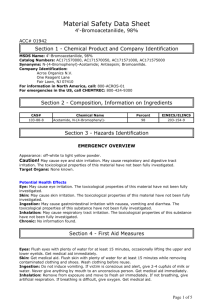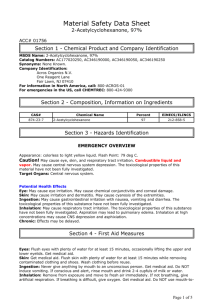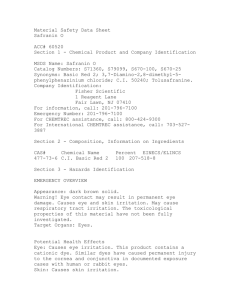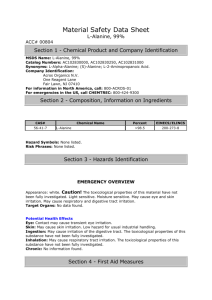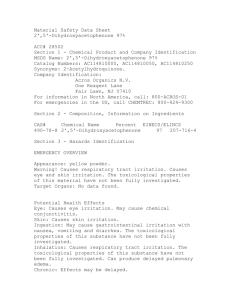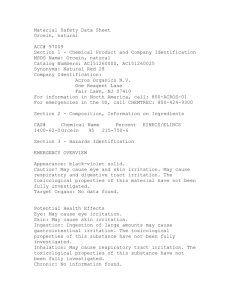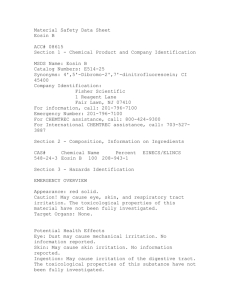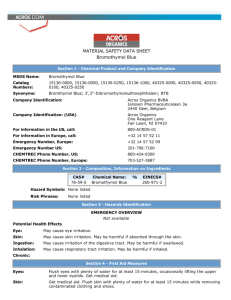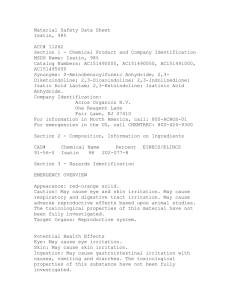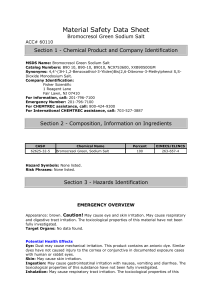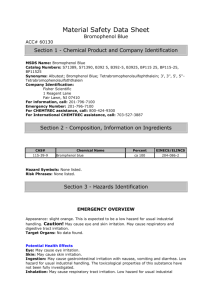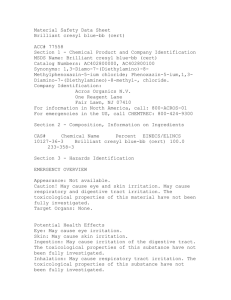Bromothymol blue
advertisement
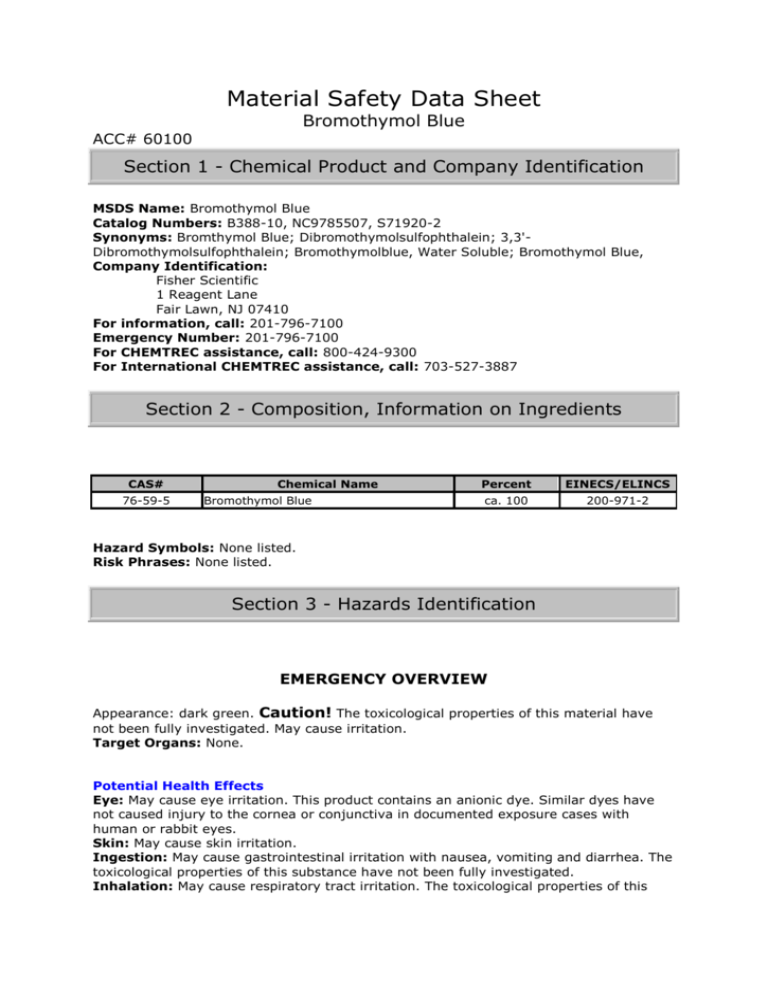
Material Safety Data Sheet Bromothymol Blue ACC# 60100 Section 1 - Chemical Product and Company Identification MSDS Name: Bromothymol Blue Catalog Numbers: B388-10, NC9785507, S71920-2 Synonyms: Bromthymol Blue; Dibromothymolsulfophthalein; 3,3'Dibromothymolsulfophthalein; Bromothymolblue, Water Soluble; Bromothymol Blue, Company Identification: Fisher Scientific 1 Reagent Lane Fair Lawn, NJ 07410 For information, call: 201-796-7100 Emergency Number: 201-796-7100 For CHEMTREC assistance, call: 800-424-9300 For International CHEMTREC assistance, call: 703-527-3887 Section 2 - Composition, Information on Ingredients CAS# 76-59-5 Chemical Name Bromothymol Blue Percent EINECS/ELINCS ca. 100 200-971-2 Hazard Symbols: None listed. Risk Phrases: None listed. Section 3 - Hazards Identification EMERGENCY OVERVIEW Appearance: dark green. Caution! The toxicological properties of this material have not been fully investigated. May cause irritation. Target Organs: None. Potential Health Effects Eye: May cause eye irritation. This product contains an anionic dye. Similar dyes have not caused injury to the cornea or conjunctiva in documented exposure cases with human or rabbit eyes. Skin: May cause skin irritation. Ingestion: May cause gastrointestinal irritation with nausea, vomiting and diarrhea. The toxicological properties of this substance have not been fully investigated. Inhalation: May cause respiratory tract irritation. The toxicological properties of this substance have not been fully investigated. Chronic: Allergic reactions have occured with similar compounds. Section 4 - First Aid Measures Eyes: Flush eyes with plenty of water for at least 15 minutes, occasionally lifting the upper and lower eyelids. Get medical aid. Skin: Get medical aid if irritation develops or persists. Flush skin with plenty of soap and water. Ingestion: If victim is conscious and alert, give 2-4 cupfuls of milk or water. Never give anything by mouth to an unconscious person. Get medical aid. Inhalation: Remove from exposure to fresh air immediately. If not breathing, give artificial respiration. If breathing is difficult, give oxygen. Get medical aid. Notes to Physician: Treat symptomatically and supportively. Section 5 - Fire Fighting Measures General Information: As in any fire, wear a self-contained breathing apparatus in pressure-demand, MSHA/NIOSH (approved or equivalent), and full protective gear. During a fire, irritating and highly toxic gases may be generated by thermal decomposition or combustion. Runoff from fire control or dilution water may cause pollution. Extinguishing Media: Use alcohol foam, carbon dioxide, or water spray when fighting fires involving this material. In case of fire, use water, dry chemical, chemical foam, or alcohol-resistant foam. Section 6 - Accidental Release Measures General Information: Use proper personal protective equipment as indicated in Section 8. Spills/Leaks: Vacuum or sweep up material and place into a suitable disposal container. Clean up spills immediately, observing precautions in the Protective Equipment section. Avoid generating dusty conditions. Provide ventilation. Section 7 - Handling and Storage Handling: Wash thoroughly after handling. Remove contaminated clothing and wash before reuse. Use with adequate ventilation. Minimize dust generation and accumulation. Storage: Store in a cool, dry place. Keep containers tightly closed. Section 8 - Exposure Controls, Personal Protection Engineering Controls: Facilities storing or utilizing this material should be equipped with an eyewash facility and a safety shower. Use adequate ventilation to keep airborne concentrations low. Exposure Limits Chemical Name Bromothymol Blue ACGIH none listed NIOSH OSHA - Final PELs none listed none listed OSHA Vacated PELs: Bromothymol Blue: No OSHA Vacated PELs are listed for this chemical. Personal Protective Equipment Eyes: Wear appropriate protective eyeglasses or chemical safety goggles as described by OSHA's eye and face protection regulations in 29 CFR 1910.133 or European Standard EN166. Skin: Wear appropriate protective gloves to prevent skin exposure. Clothing: Wear appropriate protective clothing to prevent skin exposure. Respirators: A respiratory protection program that meets OSHA's 29 CFR §1910.134 and ANSI Z88.2 requirements or European Standard EN 149 must be followed whenever workplace conditions warrant a respirator's use. Section 9 - Physical and Chemical Properties Physical State: Solid Appearance: dark green Odor: odorless pH: Not available. Vapor Pressure: Not available. Vapor Density: Not available. Evaporation Rate:Not available. Viscosity: Not available. Boiling Point: Not available. Freezing/Melting Point:Not available. Autoignition Temperature: Not applicable. Flash Point: Not applicable. Decomposition Temperature:Not available. NFPA Rating: (estimated) Health: 1; Flammability: 0; Reactivity: 0 Explosion Limits, Lower:Not available. Upper: Not available. Solubility: Sparingly soluble in water. Specific Gravity/Density:Not available. Molecular Formula:C27H27Br2O5SNa Molecular Weight:646.0438 Section 10 - Stability and Reactivity Chemical Stability: Stable under normal temperatures and pressures. Conditions to Avoid: Incompatible materials, dust generation, excess heat, strong oxidants. Incompatibilities with Other Materials: Strong acids, strong bases, strong oxidizing agents, strong reducing agents. Hazardous Decomposition Products: Carbon monoxide, oxides of sulfur, carbon dioxide, hydrogen bromide. Hazardous Polymerization: Will not occur. Section 11 - Toxicological Information RTECS#: CAS# 76-59-5: SJ7450000 LD50/LC50: Not available. Carcinogenicity: CAS# 76-59-5: Not listed by ACGIH, IARC, NIOSH, NTP, or OSHA. Epidemiology: No data available. Teratogenicity: No data available. Reproductive Effects: No data available. Neurotoxicity: No data available. Mutagenicity: No data available. Other Studies: No data available. Section 12 - Ecological Information No information available. Section 13 - Disposal Considerations Chemical waste generators must determine whether a discarded chemical is classified as a hazardous waste. US EPA guidelines for the classification determination are listed in 40 CFR Parts 261.3. Additionally, waste generators must consult state and local hazardous waste regulations to ensure complete and accurate classification. RCRA P-Series: None listed. RCRA U-Series: None listed. Section 14 - Transport Information US DOT IATA RID/ADR IMO No Shipping Name: information available. Canada TDG No information available. Hazard Class: UN Number: Packing Group: Section 15 - Regulatory Information US FEDERAL TSCA CAS# 76-59-5 is listed on the TSCA inventory. Health & Safety Reporting List None of the chemicals are on the Health & Safety Reporting List. Chemical Test Rules None of the chemicals in this product are under a Chemical Test Rule. Section 12b None of the chemicals are listed under TSCA Section 12b. TSCA Significant New Use Rule None of the chemicals in this material have a SNUR under TSCA. SARA Section 302 (RQ) None of the chemicals in this material have an RQ. Section 302 (TPQ) None of the chemicals in this product have a TPQ. Section 313 No chemicals are reportable under Section 313. Clean Air Act: This material does not contain any hazardous air pollutants. This material does not contain any Class 1 Ozone depletors. This material does not contain any Class 2 Ozone depletors. Clean Water Act: None of the chemicals in this product are listed as Hazardous Substances under the CWA. None of the chemicals in this product are listed as Priority Pollutants under the CWA. None of the chemicals in this product are listed as Toxic Pollutants under the CWA. OSHA: None of the chemicals in this product are considered highly hazardous by OSHA. STATE CAS# 76-59-5 is not present on state lists from CA, PA, MN, MA, FL, or NJ. California No Significant Risk Level: None of the chemicals in this product are listed. European/International Regulations European Labeling in Accordance with EC Directives Hazard Symbols: Not available. Risk Phrases: Safety Phrases: WGK (Water Danger/Protection) CAS# 76-59-5: No information available. Canada CAS# 76-59-5 is listed on Canada's DSL List. CAS# 76-59-5 is listed on Canada's DSL List. This product does not have a WHMIS classification. CAS# 76-59-5 is not listed on Canada's Ingredient Disclosure List. Exposure Limits Section 16 - Additional Information MSDS Creation Date: 12/12/1997 Revision #2 Date: 8/02/2000 The information above is believed to be accurate and represents the best information currently available to us. However, we make no warranty of merchantability or any other warranty, express or implied, with respect to such information, and we assume no liability resulting from its use. Users should make their own investigations to determine the suitability of the information for their particular purposes. In no event shall Fisher be liable for any claims, losses, or damages of any third party or for lost profits or any special, indirect, incidental, consequential or exemplary damages, howsoever arising, even if Fisher has been advised of the possibility of such damages.
